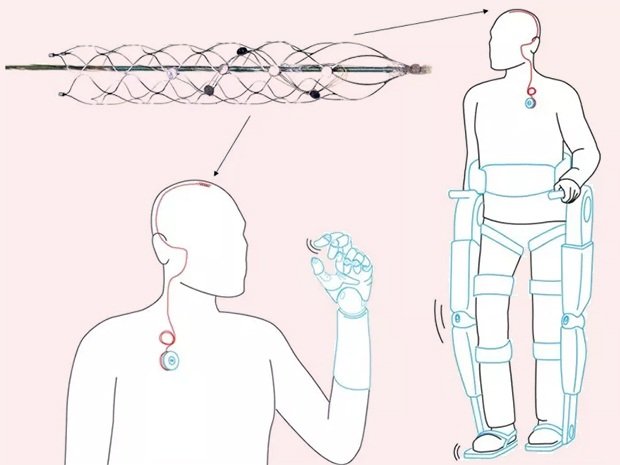
Brain implants of the “stentrode” type, which are delivered to the brain along with the blood stream and read the signal of neurons, Being in the blood vessels next door
Ilon Mask is known as a man with exceptionally practical thinking. He never dreams, but sets out concrete plans, which then come to life. Even the most ambitious and fantastic projects of Ilona Mask, which no one believed in, now make skeptics shyly tuck in their tails.
Two weeks ago, another initiative of Ilona Mask became known – the recruitment of employees to a new company Neuralink began. Probably, she will develop a neurointerface – a converter of analog signals of the brain into digital signals of the computer and back. What does the neurobiology and neuroinformatics experts think about this initiative?
The company Neuralink is still shrouded in a veil of secrecy. The news of the recruitment of employees on March 27 was first reported by the newspaper Wall Street Journal followed by a note by the news agency Reuters . In both cases, there is very little factual information in the text, but a lot of speculation.
It is well known that the company was registered in July 2016 in California, and plans to conduct research on medicine in documents. The names of the first employees are known, among them famous scientists Vanessa Tolos, engineer and specialist in flexible electrodes from the Lawrence Livermore National Laboratory, Philip Sabes, professor of the University of California at San Francisco, studying brain control and Timothy Gardner, a professor at Boston University who is known for his operations On the implantation of electrodes in the brain of finches for the study of bird singing.
Proceeding from this, journalists suggest that Neuralink will develop implantable brain implants Antata as part of the neurointerface. It only remains to guess what Ilon Mask is going to use these neurointerfaces for. But knowing the ambitious nature of the entrepreneur, we can assume that this will not be a highly specialized medical device, but a commercial device for mass use. Something that will give people new abilities and new opportunities. It should be noted that to date, no experimental interface such as the brain-computer interface (BCI) is allowed for clinical use.
Ilon himself gave several clues in his speech at the Code conference in the past Year. He said that the neurointerface should become a “digital layer over the cerebral cortex,” and its components need not be implanted surgically. Instead, the equipment can be placed by injection into the neck, and itself will fall into the brain with the blood flow .
Edition IEEE Spectrum took comments from experts in this field. Although they know perfectly well the difficulties of creating neuroimplants, they expressed enthusiasm in connection with the project of a well-known businessman and visionary: “Ilon Mask is a man who is ready to take risks and invest big money, so it will be great to see that he will do it [нейроинтерфейсами] “Says Thomas Oxley, a neuroscientist who has been developing the medical brain implant since 2010 and hopes to begin clinical trials in 2018.
Neuroimplants are already being used in medical practice. About 150 thousand people with Parkinson’s disease use such devices – electrodes are implanted deep into the brain and generate regular electrical impulses.
Mary Lou Jepsen of the Openwater start-up, who develops non-invasive neuro-interfaces for brain scans and telepathy, warns of the danger of introducing extraneous objects into the brain.
The researchers are experimenting with similar implants to treat depression and other neuropsychiatric disorders.
, Even non-invasively through the flow of blood. They say that this can have unpredictable consequences.
Thomas Oxley’s comment is particularly interesting, because he invented stentrode brain implants that are delivered to the brain along with blood flow. He not only supports this method of implantation, but also is the executive director of Synchron, which develops such devices and is about to begin clinical trials in Australia in 2018. He says that stentrodes, on the contrary, are characterized by increased safety, because they do not contact the tissues of the brain. They enter the blood vessels that nourish the neurons, and record the signal of the neurons from there, being in close proximity to the neuron. With proper signal processing, it can be deciphered and used, for example, to control the exoskeleton for the movement of paralyzed people (in the illustration at the beginning of the article).
If Mask chooses such a method of delivering electronics to the brain, the result should not be expected in the near future Time, says Oxley. His team has been working on the catheter positioning system in the motor department of the brain for two years already. But such devices have a very large potential, since controlling the exoskeleton with the power of thought will help millions of patients around the world. And not only sick people. All old men will like to move with great speed, controlling the metal frame in the style of “transformer.”
There are other technologies of neuroimplants with which Ilon Mask can experiment: these are flexible polymer probes, a micro-ECoG cylinder hung over the brain , Carbon fiber electrodes or so-called neural dust – a network of tiny wireless electrodes scattered throughout the nervous system. In this area, active scientific research is underway, so that Ilona Mask will be the one to choose from.
It’s interesting that the managers of startups in the field of neurobiology are happy to accept a new competitor. In their opinion, the arrival of Ilona Mask in neurobiology means that this industry is ripe for a big breakthrough: “This is a very significant moment,” says Thomas Oxley. – The scope of the neurointerfaces goes to the central scene in the Silicon Valley, it was recognized as one of the most promising. “
What scientists think about Neuralink – the company of neurointerfaces Ilona Mask / Geektimes. Neuralink








